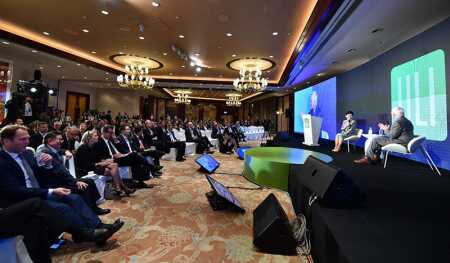Hong Kong’s land supply problem is not attributable to a lack of money, but rather is an issue of finding the physical space for development, as well as a matter of perception, Carrie Lam, chief executive of the Hong Kong SAR, said in her keynote presentation at the 2018 ULI Asia Pacific Summit, held in that city in June.
Her address was followed by an informal dialogue with Tom Murphy, ULI senior fellow and Joseph C. Canizaro/Klingbeil Family Chair for Urban Development, during which local issues were discussed through the perspective of Murphy’s past experience as mayor of Pittsburgh.
In her keynote, Lam focused on how best to address the issues facing Hong Kong, the most challenging and pressing of which is the longstanding land supply problem, she said. The problem has never been money, she noted. With a record fiscal surplus of HK$150 billion (US$19 billion) last year alone and total reserves totaling HK$12 trillion (US$1.5 trillion), the city is in an enviable position financially. Instead, the challenge lies in finding space physically to build the required housing, office space, and infrastructure facilities.
The problem is also something of a matter of perception, she said. With the city’s total developed land representing only 9.3 of its 424 square miles (24 percent of its 1,100 sq km) of available space, on paper there would seem to be plenty of room for new construction. But with a lack of consensus among residents, as well as various vested interests in the city unwilling to budge on surrendering land that might be pressed into service, something has to give if progress is to be made, she said.
“I appeal to people of Hong Kong: don’t just say no,” she said. “Every day I see reports or surveys saying that respondents don’t want us to touch the country parks, they don’t want reclamation, they don’t want us to take their farmland. We are stuck if everyone takes that attitude. So I appeal to everyone: we need to take Hong Kong’s immediate and long-term interests into account.”
Although Hong Kong’s government has now created a land supply task force to solicit public opinion about the best way forward, Lam identified two specific ways in which Hong Kong’s chronic land shortage problem might be solved.
The first is to target one of Hong Kong’s large outlying islands, Lantau, as a source of future major construction activity. Lantau is significantly larger than Hong Kong island but has a far smaller population. As a result, it has enough physical space for a large number of new buildings and infrastructure.
“Together with my team, I’m now looking into the further potential of Lantau,” Lam said. “Inevitably, this will involve reclamation because people are very attached to country parks, and Lantau has two. Also, southern Lantau is simply beautiful, and I don’t think we should forgo the opportunity to conserve [it].”
Another reason Lantau has been designated as what will probably be the major new source of land supply for Hong Kong is that it currently hosts two major infrastructure projects—the Hong Kong–Macau–Zhuhai bridge, which links it to cities on the west side of the Pearl River Delta, and the tunnel/bridge facility that will connect the island to Hong Kong’s northern New Territories near the border with Shenzhen.With the Hong Kong–Macau–Zhuhai bridge due to open in the second half of this year and the New Territories connection by 2020, “Lantau is no longer an isolated island, but will be very well connected and positioned within the Guangdong/Macau/Hong Kong bay area,” Lam said.
The second solution to the land shortage proposed by Lam is the long-term evolution of Hong Kong from standalone city to just one part of a planned regional Greater Bay Area (GBA) that would link 18 cities and 68 million people as a new economic area primed to foster finance and technical innovation. The creation of the GBA is the result of a policy first touted by mainland Chinese authorities as early as 2014. It remained under the radar for several years, emerging only recently following its endorsement at the highest levels of the Chinese government.
Lam suggested that the impending upgrades to Hong Kong’s transportation infrastructure, which also include the imminent opening of the city’s link to China’s sprawling high-speed rail network, will soon allow Hong Kong workers to live cheaply in the GBA and commute daily into the city, relieving pressure on a generation of increasingly disaffected youth who currently have little chance to buy affordable housing locally.
Connectivity in Hong Kong will also be boosted by regulatory changes now in the pipeline—such as allowing unrestricted access to China for Hong Kong–registered cars—that are set to ease the administrative hassles of cross-border travel.
While it remains to be seen whether significant numbers of Hong Kong residents would be willing to migrate across the border once the new infrastructure is rolled out, it is clear that both the Chinese mainland and Hong Kong governments are determined to make integration of the GBA a reality. And although plans to create similar economically linked areas elsewhere in the world have met with mixed success, China has a track record of creating this type of massive, interconnected, urban agglomeration in other parts of the country.





